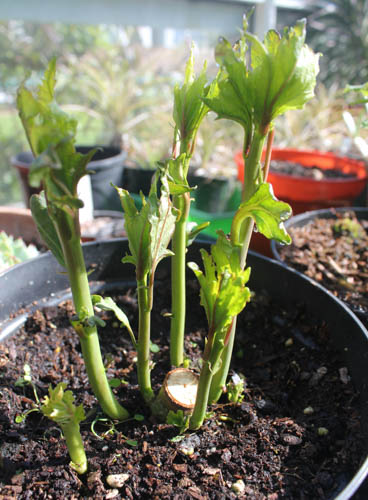
Apart from the few days of summer last month we spent most of last month in low light, constant rain and chilling winds, so the ground is still too cold and wet for sowing crops directly and will be for a while yet, so thank goodness there is plenty to do in the greenhouse.
Seeds that were sown in trays last month at a wide spacing to avoid problems with ‘damping off’ will now be growing nicely and filling the gaps, so they will need ‘pricking out’ into larger pots before the roots become interwoven. Carefully loosen the compost around each seedling with a ‘dibber’, lift the seedling carefully by the first true leaf with your finger and thumb, easing them gently from the compost to avoid damage retaining as much compost on the roots as possible. Use the dibber to make a hole in the compost in a new 9cm pot of compost, large enough to accommodate the roots and plant the seedlings slightly deeper than they were in the tray, up to the depth of the first true leaves. Water in gently with tepid tap water, changing to rainwater once they become established and don’t forget to label them individually.
Check seedlings every day, and only water if necessary, they need watering less often when light and temperature levels are low. Ventilate the glasshouse whenever temperatures allow, using roof and side ventilation rather than leaving the door open, to avoid cold draughts, aiming for a balance between light and heat, so your plants don’t become ‘leggy’. If you haven’t had time to sow, there is still time to buy ‘plug plants’ from your local garden centre or from the internet for growing on.
Young plants need ‘hardening off’- being acclimatised to outdoor conditions before they are permanently planted. To do this, put them outdoors in a sheltered position during the day and bring them indoors at night for ten to fourteen days, once the weather warms, then leave them outdoors, overnight, for another week until planting, covering them with horticultural fleece if needed.
Water and feed, tender plants which were encouraged into growth last month and maintain cooler temperatures during periods of low light to encourage compact growth, too much heat in low light makes them ‘leggy’ and soft growth is more susceptible to damage, pests and diseases.
Inspect plants daily for pests and diseases as it is easier to control infestations before they become established. Look out for aphids, and whitefly and red spider mite on the underside of leaves. Use organic spays for aphids and whitefly and increase the humidity around plants by misting with soft tepid water to discourage red spider mite which dislike dry air. Planting French marigolds in the greenhouse will discourage whitefly but only before infestation occurs.
It is not too late to make two more sowings of runner beans in pots or ‘Root Trainers’ in mid- May and mid – June, to extend the cropping season and squashes or courgettes individually in 9cm pots, too. Happy gardening! Matt


